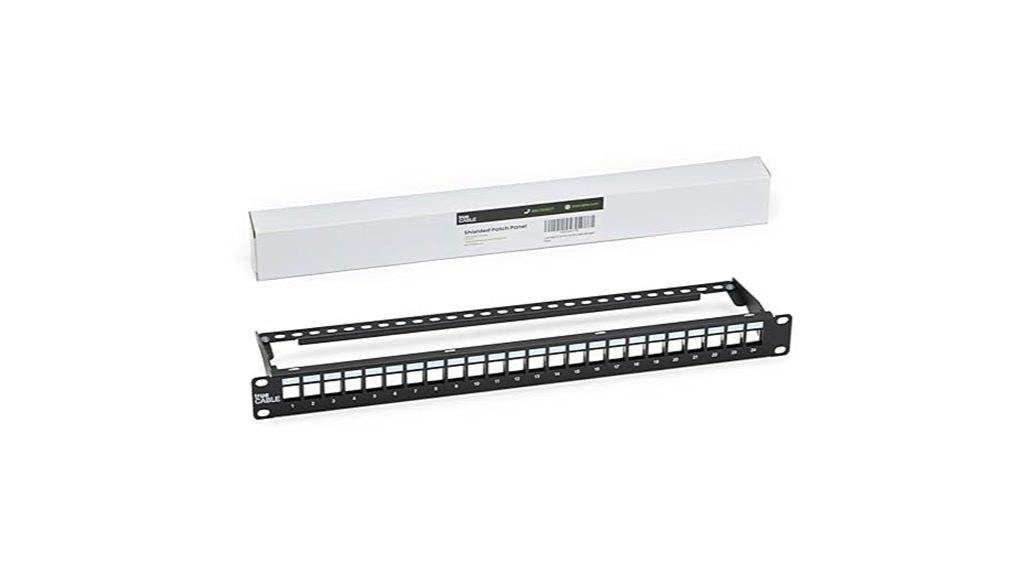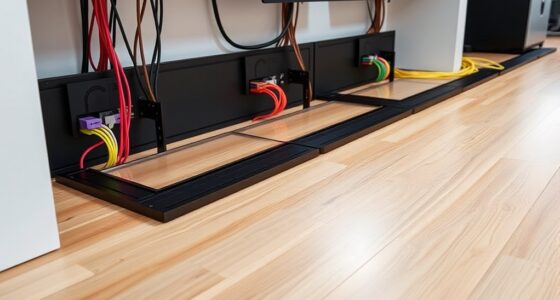As network demands grow, choosing the right high-density patch panel becomes essential for maintaining efficiency and reliability. With so many options available, it’s important to consider factors like space, compatibility, and ease of installation. The best panels can streamline your setup while supporting future upgrades. Want to find out which models stand out in 2025 and why they might be the perfect fit for your network?
ICC Voice 6P2C Telco Patch Panel (24 Ports, RJ-11)

If you’re setting up a high-performance voice network, the ICC Voice 6P2C Telco Patch Panel is an excellent choice, especially with its 24 RJ-11 ports designed for busy telecommunications environments. It features a durable 16-gauge steel construction and includes a dust cover to protect connectors. The panel supports seamless integration with 25-pair Telco cables through its rear Amphenol-compatible connector. With high-retention gold-plated contacts supporting over 750 mating cycles, it ensures reliable, clear voice communication. Easy to install in standard 19-inch racks, it also offers cable management options with hook and loop ties, making setup efficient and organized.
Best For: businesses and telecommunications professionals seeking a reliable, durable patch panel for high-performance voice and network applications in busy environments.
Pros:
- Durable 16-gauge cold-rolled steel construction ensures longevity and robustness
- Supports over 750 plug-to-jack mating cycles for long-term use
- Easy installation in standard 19-inch EIA racks with included mounting hardware
Cons:
- Limited to 24 RJ-11 ports, which may not accommodate larger setups without additional panels
- Uses a 2-wire USOC wiring scheme, potentially limiting compatibility with some systems
- No integrated labeling system beyond a write-on area, which may require additional organization tools
ICC 48 Port Keystone Patch Panel with Rackmount Housing

Looking for a space-saving solution that maximizes your rack’s capacity? The ICC 48 Port Keystone Patch Panel with Rackmount Housing offers a compact, high-density option for organizing network connections in standard 19” racks. Made from durable 16-gauge steel with a black powder coat, it provides long-lasting strength and a professional look. Its flush-mount design and pre-numbered ports simplify installation and management, supporting versatile configurations with ICC’s slim-profile keystone jacks for CAT6A, HDMI, USB, and more. With easy mounting and removal, it’s ideal for high-density environments needing reliable, flexible connectivity within limited space.
Best For: IT professionals and network installers seeking a high-density, space-efficient patch panel for organizing multiple keystone connections in standard 19-inch racks.
Pros:
- High-density design supports up to 48 ports in just 1U of rack space
- Durable construction with 16-gauge steel and professional black powder coat finish
- Easy to install and manage with pre-numbered ports and included mounting hardware
Cons:
- Keystone jacks are sold separately, requiring additional purchase for full setup
- Limited to compatible ICC keystone jacks; incompatible connectors may not fit
- May require a keystone connector removal tool for quick port changes
trueCABLE Shielded 24 Port 19” Patch Panel with Cable Management Bar

The trueCABLE Shielded 24 Port 19” Patch Panel with Cable Management Bar is ideal for high-density network setups that demand reliable EMI, RFI, and ESD protection. It features a tooless, modular design with 24 shielded ports, supporting various shielded Ethernet cables and keystone jacks. The included cable management bar helps organize cables efficiently, while the ground wire ensures proper grounding for static discharge. Constructed from UL Listed, RoHS Compliant materials, it fits standard 19” racks and offers individually numbered ports for easy identification. Backed by trueCABLE’s FOREVER WARRANTY, this patch panel provides a flexible, durable solution for professional and residential networks.
Best For: professional IT installers, data centers, and residential network setups requiring high-density, shielded cable management with reliable EMI/RFI/ESD protection.
Pros:
- Supports shielded Ethernet cables and keystone jacks for enhanced interference protection.
- Includes a cable management bar and ground wire for organized and safe installations.
- Individually numbered ports facilitate quick identification and labeling.
Cons:
- Not recommended for 10G high-speed unshielded Cat6A applications due to crosstalk standards.
- Requires a minimum 8” rack depth for proper installation clearance.
- May be over-specification for small or low-density networking needs.
ICC CAT5e Feed-Through Patch Panel with 24 Ports

The ICC CAT5e Feed-Through Patch Panel with 24 ports is designed for high-density network setups where space efficiency and reliable connectivity are critical. Its 1U horizontal rackmount fits perfectly into standard 19-inch racks, maximizing space. The panel features RJ-45-to-RJ-45 connections on both sides, allowing quick, punch-down-free patching. Its modular design makes upgrading and maintenance simple, with removable keystone connectors. Built from reinforced steel with a powder coat finish, it’s durable and rated for outdoor and indoor use. Supporting PoE++, it handles high-power devices, and its compliance with ANSI/TIA-568 standards ensures dependable performance for demanding networks.
Best For: professional network installers and IT managers seeking a durable, high-capacity patch panel for both indoor and outdoor high-density network environments.
Pros:
- Modular design with removable keystone connectors simplifies upgrades and maintenance
- Supports PoE++ for powering high-power devices, enhancing versatility
- Rugged reinforced steel construction with powder coat finish ensures durability in demanding environments
Cons:
- May be over-spec for small or low-density network setups
- Installation requires careful handling due to weight and metal construction
- No punch-down option, which could limit compatibility with certain cabling systems
48 Port High Density 1U Patch Panel UTP with Inline Keystone CAT6 Coupler

Ideal for dense network environments, the Port High Density 1U Patch Panel UTP with Inline Keystone CAT6 Coupler maximizes rack space by offering 48 ports within a single rack unit. It enables you to organize and centralize multiple Cat6 Ethernet connections onto punch-down blocks or jacks, creating a clean, efficient setup. Numbered ports and labeling fields make identification straightforward, simplifying cable routing and maintenance. Built with durable, power-coated steel, it meets industry standards like TIA-568-C and RoHS. This patch panel enhances network performance by ensuring proper cable termination, reducing interference, and allowing easy reconfiguration or troubleshooting without rewiring.
Best For: IT professionals and network administrators seeking a high-density, organized, and durable patch panel solution for large-scale or space-constrained network environments.
Pros:
- Maximizes rack space with 48 ports in a compact 1U design.
- Facilitates organized cable management with numbered ports and labeling fields.
- Supports easy reconfiguration and troubleshooting, reducing maintenance time.
Cons:
- May require additional tools for punch-down terminations if not pre-populated.
- Limited to Cat6 cabling, which might not suit higher-speed network upgrades.
- Steel construction, while durable, could be heavier and less flexible for certain rack setups.
Factors to Consider When Choosing a High‑Density Patch Panel
When selecting a high-density patch panel, you need to consider port density and size to fit your space and network needs. Compatibility with industry standards and ease of installation also play crucial roles in ensuring reliable performance. Don’t forget to evaluate cable management features and shielding options to minimize interference and keep your setup organized.
Port Density and Size
Choosing a high-density patch panel involves balancing port density and physical size to meet your network’s current and future needs. Higher port density lets you connect more devices in a smaller space, optimizing rack utilization. Compact panels, typically 1U in height, can accommodate 48 or more ports, making efficient use of limited rack space. However, increasing port density requires careful cable management to prevent congestion and maintain airflow, avoiding overheating. The physical size of these panels is designed to maximize port count while fitting within standard 19-inch racks. Picking a panel with the right port density ensures scalability, allowing your network to expand without needing additional rack space. This balance is essential for a reliable, future-proof infrastructure.
Compatibility and Standards
Selecting a high-density patch panel requires ensuring it adheres to industry standards for safety, performance, and compatibility. You should verify it complies with ANSI/TIA-568, UL, and RoHS to guarantee reliable operation and safety. Check that the patch panel supports your network’s Ethernet category, whether Cat5e, Cat6, or Cat6A, to meet your bandwidth needs. Compatibility with connector types like RJ-45, RJ-11, or keystone jacks is essential for seamless integration. Also, confirm the port count and spacing suit your high-density setup and fit your cable management accessories. Additionally, ensure the patch panel supports features like PoE, shielding, or specific wiring schemes such as T568A or T568B, which are vital for your network’s performance and future scalability.
Ease of Installation
Ease of installation is a critical factor that can significantly impact your setup process. Look for patch panels with clearly labeled ports and easily accessible connection points to speed up wiring and troubleshooting. Choose panels that support toolless or minimal-installation features, such as snap-in keystone jacks or RJ-45-to-RJ-45 connections, to save time during setup. Ensure the panel includes mounting hardware and cable management accessories like tie wraps or bars, making installation more organized and efficient. Select designs with standardized dimensions, like 1U height and 19-inch width, for straightforward mounting and alignment in your rack. Finally, opt for panels with intuitive construction and connection mechanisms that don’t require specialized tools or extensive technical training, simplifying the entire installation process.
Cable Management Features
Effective cable management is essential for maintaining an organized and reliable network setup. Look for patch panels with features like cable ties, hooks, and routing channels to keep cables secure and prevent clutter. Integrated labeling areas and numbered ports make it easier to identify connections and troubleshoot issues quickly. Dust covers and protective barriers shield connectors from dirt, dust, and environmental hazards, prolonging equipment lifespan. Adjustable or removable cable management bars offer flexible routing options, allowing quick reconfiguration as your network grows or changes. Good cable management reduces strain on connectors and cables, minimizing the risk of disconnections and signal degradation. Prioritizing these features ensures your high-density patch panel supports both easy maintenance and long-term network stability.
Shielding and Interference
Shielding plays a crucial role in high-density patch panels by reducing electromagnetic interference (EMI), radio frequency interference (RFI), and electrostatic discharge (ESD), all of which can compromise signal quality. Proper shielding ensures signals stay clear, preventing data corruption, crosstalk, and network instability. To maximize effectiveness, ensure the shielded patch panel is properly grounded so interference and static can drain safely to ground. Compatibility between shielded cables, keystone jacks, and the patch panel’s shielding features is vital for optimal performance. Keep in mind that unshielded or poorly shielded panels are more vulnerable to interference, especially in environments with high electromagnetic noise like data centers or industrial setups. Choosing a panel with robust shielding helps maintain reliable, high-speed network connectivity.
Build Quality and Durability
Choosing a high-density patch panel with solid build quality is essential to ensure long-term reliability and performance. Look for panels constructed from durable materials like cold-rolled steel, which can withstand frequent connections and disconnections without damage. Gold-plated contacts, especially with 50 micro-inch gold, improve corrosion resistance and ensure consistent electrical performance over many mating cycles. A well-built panel features reinforced steel frames and powder-coated finishes that resist physical damage and environmental factors, extending its lifespan. High-quality patch panels support at least 750 mating cycles, ensuring durability and reliable connectivity over time. Proper construction prevents signal degradation, crosstalk, and interference, helping maintain optimal network integrity and reducing the need for frequent replacements.
Conclusion
Choosing the right high-density patch panel ensures your network stays organized, scalable, and protected from interference. Focus on your space needs, port density, and compatibility with industry standards. Prioritize panels with easy installation, solid cable management, and durability for long-term use. By selecting the best options for your environment, you’ll optimize connectivity, support high-speed data transfer, and future-proof your network infrastructure effortlessly. Make a smart choice and keep your network running smoothly now and in 2025.








